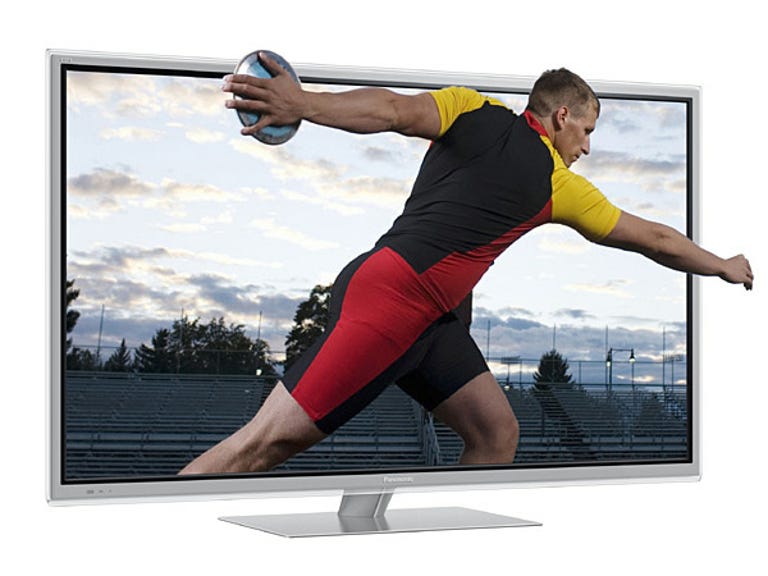 Why You Can Trust CNET
Why You Can Trust CNET Panasonic Viera TH-L47ET50A review: Panasonic Viera TH-L47ET50A
The Panasonic Viera TH-L47ET50A is a neat and stylish TV with good overall performance — except for its weak 3D.
System
Now that Panasonic is moving more strongly into the LCD TV field, it seems to be keeping its 3D options open. This TV — a full high-definition 47-inch (119.2cm by my measurement) unit — uses active 3D technology. That is, the eyewear flashes the lenses between transparent and opaque states in synchronisation with the display of the left and right images on the TV screen. But the company also offers a passive 3DTV in the same size, although at a lower price and with a reduced set of features.
The Good
The Bad
The Bottom Line
The active glasses are synced with the TV using a Bluetooth connection. At 30 grams, they are fairly light and comfortable, but you only get one set with the TV. Additional sets cost AU$99 each.
The TV is well equipped: four HDMI sockets (plus support for composite and component video), three USB (you can plug an HDD in to one for recording and time shifting), Ethernet and built-in Wi-Fi. It also has an SD card slot.
The TV's frame is pleasingly thin — only 28mm from the picture to the edge at the sides and top — and is mostly a light silver-grey colour. The swivel stand with which it is supplied has a sloped pedestal, which gives the impression that the TV is floating free.
Picture
This is getting a little tedious, but you need to make a couple of changes to optimise the TV's picture once you've done the basic set-up — as you'll need to with every TV we've reviewed recently. Wind down the sharpness control to remove the edginess, and for high-definition content — especially Blu-rays — go to the Advanced Settings in the picture menu and switch off "16:9 Overscan". Having this switched on scales the picture up by 5 per cent, causing its edges to overflow the screen. This "feature" is a hangover from analog TV-transmission days. You may also want to play with the "24p Smooth Film" mode, located in the same place. This defaults to "Max" with Blu-ray content. "Mid" reduces picture judder, and avoids the heat-haze artefacts created by "Max".
That done, the 2D picture looked bright and beautiful under normal room lights, and still quite respectable in a dark room. The backlight seemed to be reasonably well localised to the bright spots of the picture, and on a mostly black screen it was remarkable even in darkness. Switching on the "Eco" mode allowed the TV to adjust its brightness according to ambient light. This tended to make the brightness just a bit too dull for my taste.
This was not a good TV for 3D. There was too much crosstalk to allow for a really satisfying 3D experience. The primary problem was that where one eye is supposed to be seeing black, any white intended for the same spot in the other eye leaked through quite strongly. On the static test pattern, this resulted in about 50 per cent to 60 per cent leakage. On Monsters vs. Aliens, in addition to this type of crosstalk, the towers of the Golden Gate Bridge were ghosted at a low level against the blue sky. On Happy Feet Two, my eyes became tired fairly quickly because of the confusing ghosting on penguins' faces. The 3D effect simply wasn't very strong, either, probably in large part because of this.
Goodies
The media player supports the usual range of goodies, including MPEG2, MP4 and DivX videos, and MP3, AAC, WMA and, unusually, FLAC music. For photos, you get JPEG and MP0 — the standard format for 3D digital stills. These can be accessed from USB or SD media plugged directly in to the TV. You can also access content from your computer network using DLNA, including photos and videos. The performance with all of this was good, with snappy display of content; it took less than a second for each photo to be thrown up on the screen from when you press the arrow to go to the next one. The sharpness control was a bit too high for these, but dragging it all the way down to zero seemed to soften the pictures too much. Choose somewhere intermediate.
The TV comes with a standard remote control (albeit one with a glossy surface, unlike the matte finish of lower-model remotes), but your Android or iOS device can also control the TV using a free app. I used the iOS version. The effectiveness of this was reduced by the five seconds or so it took to connect every time it was started, or the iPad switched on again. That aside, it has some nice functions, including screens for sliding the selection around and the ability to push video and photos (but not music) from the device to the TV. It popped up a keyboard when required for using the internet. You can also plug a standard USB keyboard in to the TV for that purpose.
The internet stuff is Panasonic's normal selection, with a few useful things pre-installed: BigPond Movies, Quickflix, ABC iView, YouTube, Facebook and so on, with lots more available for free download from the "Viera Connect Marketplace". The TV supports Skype as well, but you'll need Panasonic's optional USB Skype camera.
Overall
The Panasonic Viera TH-L47ET50A TV is a solid performer on most fronts, with good internet capabilities. But if it's fine 3D that you really want, you should look elsewhere.


